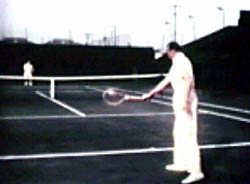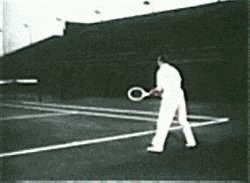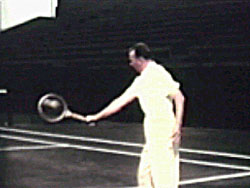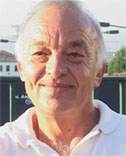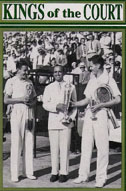Great Shots in Tennis History:
The Don Budge Backhand
By Ed Atkinson
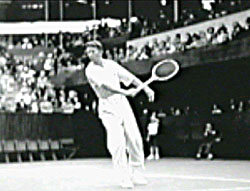 |
More than six decades ago a tall, redheaded teenager from Oakland, California unveiled to an astonished tennis world what is almost universally acclaimed to be the greatest tennis stroke of all time - the J. Donald Budge Backhand. Budge's backhand weapon was so formidable it forced every opponent he faced to drastically alter their tactics and rethink the way they played the game. No one was able to follow their serve to net successfully against Budge. So great a player was he that in the 1948 World Professional Championships Budge, 10 years past his prime, broke Jack Kramer, the greatest serve and volley player the game has seen, in his first two service games, forcing the reigning Wimbledon and U.S. champion to stay back behind his usually devastating first serve. |
My first contact with Budge occurred when I was a fourteen year old, stringing rackets at the Los Angles Tennis Club. This was more than a decade after Budge had defined the Grand Slam by becoming the first player to win the 4 major championships in a single year. One day, the tennis pro handed me a racket to string. I had never seen anything like it! The handle was over five inches around, bare wood with no leather grip. The racket's shoulders were so thick I could barely fasten them to the stringing machine. I later weighed the racket at 16 and ½ ounces. The racket belonged to the famous champion Don Budge. |
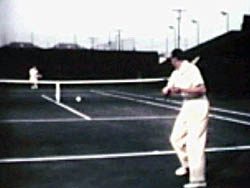 |
Budge's turn - shoulders sideways, weight on the rear foot |
|
Not believing anyone could wield this monstrous club, I made a point to see him play as soon as possible. My chance arrived the next day when Budge played a social doubles match with a female club member as his partner, a 3.5 player by today's standards. Their opponent's were two solid male members. In the first game, Budge's opponent won 14 straight points serving to Don's partner. However, he also lost 14 straight points serving to Budge. In fact he never made contact with a Budge service return. Budge hit these returns from 4 feet inside the baseline. So this was the player who had won the Australian, French (in his only appearance there), Wimbledon, and U.S. Championships in a single year, losing only 5 sets in 28 Grand Slam matches! I was a believer. |
|
At contact, Budge has transferred weight forward to front foot. |
The next year I ball boyed an indoor match between Budge and Pancho Gonzalez on a lightning fast surface. Although it may seem difficult to believe, I witnessed a Budge service return that struck Gonzalez's racket before he had completely recovered from the follow-through on his own famed service motion. This was another example of the phenomenal shot making ability Budge still possessed, 15 years after his famous Slam year. The Grip Budge used an extreme version of the Eastern grip, with the knuckle of the forefinger being on top of the frame, and the thumb placed diagonally across the back of the grip for support. This grip enabled him to hit flat, with slice, and with topspin. |
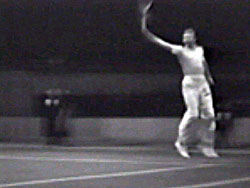 |
|
The forces generated by Budge's swing often caused
him to become airborne on follow-through |
Footwork Budge assumed a sideways position with his right shoulder pointing toward the net for as long as possible. At the beginning of the stroke, the weight is on the rear foot then shifted to the front foot as the racket comes through. Very often, Budge would become airborne on his follow-through, an indication of the tremendous body weight he applied to the ball. The Racket Swing All great tennis strokes come naturally to players fortunate enough to possess them. Thought is replaced by instinct. Budge's backhand was a beautiful example. |
|
| An avid baseball player before taking up tennis, Budge batted left-handed. He treated the backhand as he would his left-handed baseball swing. The only exception, he released his left hand as he began the forward motion. He "just let the racket go," and the racket speed would develop instantaneously as the swing started forward. |
A unique aspect of the Budge backhand was the instantaneous
racquet head acceleration |
|
This element in Budge's stroke is unique in tennis. Most great shots are based on a more gradual acceleration of the racket to the contact point allowing the player to judge the pace of the oncoming ball before committing full power. Budge let the racket fly with full force, immediately. Blessed with 20/5 vision in both eyes, he possessed the uncanny ability to evaluate his opponent's shots almost instantaneously. Through his eyes, the game seemed to unfold in slow motion. The famous backhand was unique in one other respect. Most one handed backhands are hit with the arm closer to the body, so the arm is almost perpendicular to the ground. Budge, true to his baseball heritage, kept his arm at a diagonal through the critical part of the stroke. Budge's natural abilities and technique, combined with the 16 and ½ ounce racket, made him seem nearly in invincible on the backhand side. |
Commentary
No player in the history of the game dominated his generation as did Budge. It was common for him to run six to ten games in a row in tournament play. In the days when only the semifinalists received expense money in the Southern California Championships, a young player literally wept when Budge's name appeared on the draw as his quarterfinal opponent. This same player, who felt he had literally no chance against Budge, later went on to win the U.S. Championships.
One final circumstance that made Budge's backhand even more effective was the universal training of top player's to approach the net down the line to the backhand side. Ellsworth Vines told me when he toured against Budge, he would revert to this classic strategy in the heat of a big point, only to realize too late that he was hitting into the wheelhouse of the greatest shot the game has known.



